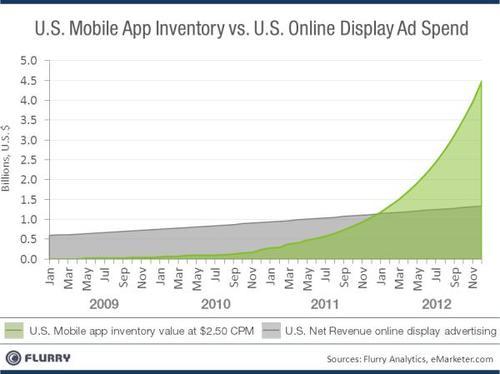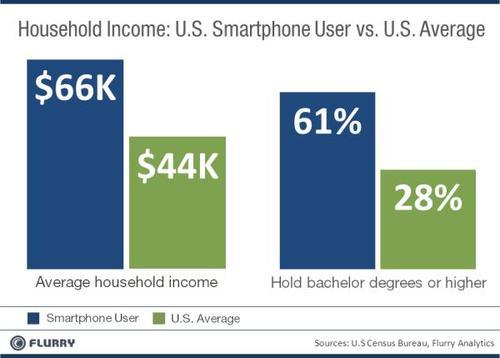Smartphones app usage, facilitated by explosive iOS and Android device adoption, has created among the fastest-growing media channels in the history of consumer technology. Flurry estimates that, worldwide, over 600 thousand apps are available for over 350 million iOS and Android devices. On average, consumers have downloaded over 65 apps per device.
While micro-transaction models, largely associated with free-to-play games, have proven the most lucrative business model for iOS and Android apps, there have been big bets placed on advertising. In addition to its own iAd initiative, Apple acquired Quattro, a mobile ad network, for $275 million in January 2010. This was shortly after Google announced its intention to acquire Admob, a rival ad network, for $750 million in November 2009.
In June 2011, Gartner projected that mobile advertising revenue would double to $3.3 billion worldwide in 2011, and grow from around $300 million to over $700 million in 2010 in North America. eMarketer, a research firm, predicts that U.S. mobile ad spending will top $1.1 billion this year.
In this report, Flurry focuses on the size and growth of available advertising inventory within iOS and Android applications. We used data from over 100,000 applications tracked by Flurry to estimate the size of this media channel. The chart below shows that U.S. app inventory is not only growing at a staggering rate, but also poised to absorb the equivalent of the entire U.S. Internet display advertising spend by the end of this year.

Reviewing the chart, we see that U.S. mobile app inventory has grown aggressively over the last year. With its growth trajectory, it will be able to absorb the entire U.S. online display ad spend by the end of the year. Another way to look at this is that, in approximately two years, mobile app inventory is growing so aggressively that it could easily meet the demand of a mature, 15-year-old form of online advertising.
To arrive at these figures, we first tracked the average number of ads shown per application session, which we found to be 4.3. The average application session is 4.2 minutes. For reference, the average session length of a website is just under 1 minute. We then looked at the number of sessions. Flurry tracks about 20% of all sessions in the market, and so we grew our numbers accordingly to come up with a market size.
We compared this inventory with the net spend on display advertising in the US. The US market currently spends a little over $12bn per annum on online display advertising. We assumed a conservative CPM (cost per 1000 impressions) of $2.50 for mobile application inventory. As a point of reference, a typical 30 second video on a large video streaming website such as Hulu has a CPM of $10-$15.
We at Flurry see four reasons why the market is growing at such a fast rate:
1) Smartphone growth – over a million smartphone devices are currently being activated on a daily basis
2) Publisher growth – The App store now has over 400,000 apps in the market and Android, with over 200,000, is catching up quickly
3) Session use growth - Flurry has previously found that smartphone users now spend more time in mobile apps per day than the average Internet users spends online.
4) Publisher integration of ads – with larger screens, targeting, and increased adoption of mobile applications, more publishers are integrating ads into their apps
Not only is inventory growing, but Flurry has also found that the average user of a smartphone is a very attractive target for advertisers. With a sample of more than 60,000 app users, we used location data and zip code statistics available from the U.S. Census Bureau to understand their demographics. On average, smartphone users are better educated and earn higher household incomes than the average of the U.S. population.

Additionally, looking at age and gender, we find that U.S. smartphone app users cluster into younger age groups and trend slightly more female.

In 1994, Hotwired.com was the first company to start selling display advertising in large quantities on the Internet. Back then, it took over six years for advertisers to embrace this model. For mobile apps, less than four years into their growth cycle, a critical mass of highly attractive consumers has been achieved. With growing awareness by brands and advertising agencies, we now expect digital advertising on mobile to take off in earnest.